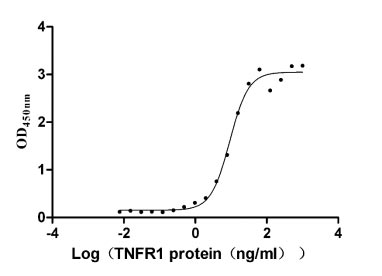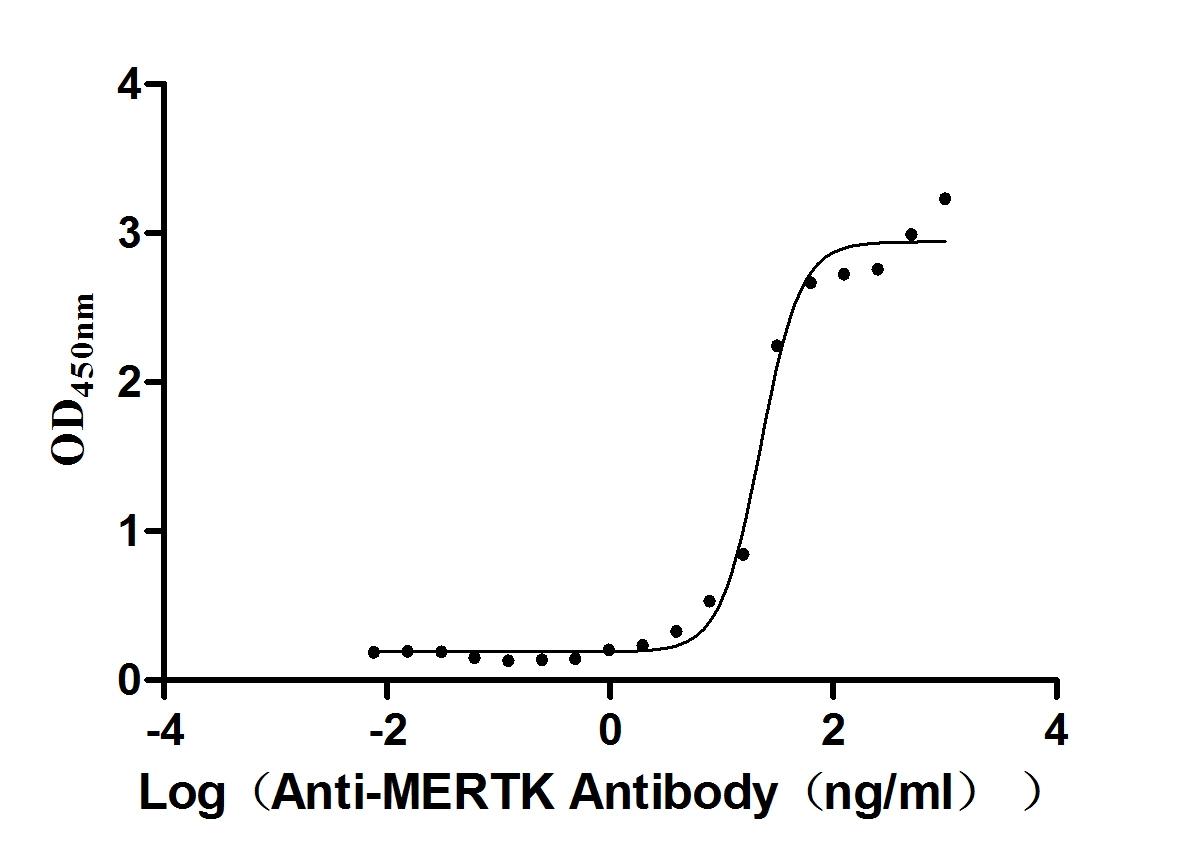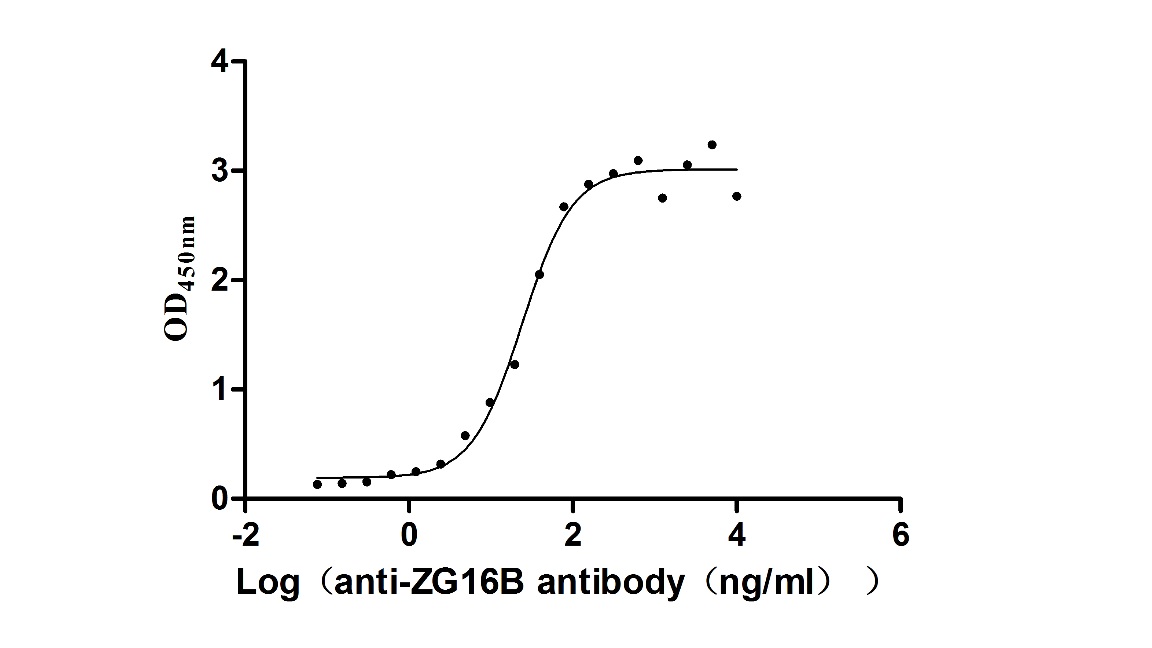Recombinant Rat Hepcidin (Hamp)
-
货号:CSB-YP860393RA
-
规格:
-
来源:Yeast
-
其他:
-
货号:CSB-EP860393RA-B
-
规格:
-
来源:E.coli
-
共轭:Avi-tag Biotinylated
E. coli biotin ligase (BirA) is highly specific in covalently attaching biotin to the 15 amino acid AviTag peptide. This recombinant protein was biotinylated in vivo by AviTag-BirA technology, which method is BriA catalyzes amide linkage between the biotin and the specific lysine of the AviTag.
-
其他:
-
货号:CSB-BP860393RA
-
规格:
-
来源:Baculovirus
-
其他:
-
货号:CSB-MP860393RA
-
规格:
-
来源:Mammalian cell
-
其他:
产品详情
-
纯度:>85% (SDS-PAGE)
-
基因名:Hamp
-
Uniprot No.:
-
别名:Hamp; Hepc; Hepcidin
-
种属:Rattus norvegicus (Rat)
-
蛋白长度:Cytoplasmic domain
-
表达区域:60-84
-
氨基酸序列D TNFPICLFCC KCCKNSSCGL CCIT
-
蛋白标签:Tag type will be determined during the manufacturing process.
The tag type will be determined during production process. If you have specified tag type, please tell us and we will develop the specified tag preferentially. -
产品提供形式:Lyophilized powder
Note: We will preferentially ship the format that we have in stock, however, if you have any special requirement for the format, please remark your requirement when placing the order, we will prepare according to your demand. -
复溶:We recommend that this vial be briefly centrifuged prior to opening to bring the contents to the bottom. Please reconstitute protein in deionized sterile water to a concentration of 0.1-1.0 mg/mL.We recommend to add 5-50% of glycerol (final concentration) and aliquot for long-term storage at -20℃/-80℃. Our default final concentration of glycerol is 50%. Customers could use it as reference.
-
储存条件:Store at -20°C/-80°C upon receipt, aliquoting is necessary for mutiple use. Avoid repeated freeze-thaw cycles.
-
保质期:The shelf life is related to many factors, storage state, buffer ingredients, storage temperature and the stability of the protein itself.
Generally, the shelf life of liquid form is 6 months at -20°C/-80°C. The shelf life of lyophilized form is 12 months at -20°C/-80°C. -
货期:Delivery time may differ from different purchasing way or location, please kindly consult your local distributors for specific delivery time.Note: All of our proteins are default shipped with normal blue ice packs, if you request to ship with dry ice, please communicate with us in advance and extra fees will be charged.
-
注意事项:Repeated freezing and thawing is not recommended. Store working aliquots at 4°C for up to one week.
-
Datasheet :Please contact us to get it.
相关产品
靶点详情
-
功能:Liver-produced hormone that constitutes the main circulating regulator of iron absorption and distribution across tissues. Acts by promoting endocytosis and degradation of ferroportin/SLC40A1, leading to the retention of iron in iron-exporting cells and decreased flow of iron into plasma. Controls the major flows of iron into plasma: absorption of dietary iron in the intestine, recycling of iron by macrophages, which phagocytose old erythrocytes and other cells, and mobilization of stored iron from hepatocytes.; Has strong antimicrobial activity against E.coli ML35P N.cinerea and weaker against S.epidermidis, S.aureus and group b streptococcus bacteria. Active against the fungus C.albicans. No activity against P.aeruginosa.
-
基因功能参考文献:
- Acidic Polysaccharide from Angelica sinensis Reverses Anemia of Chronic Disease Involving the Suppression of Inflammatory Hepcidin and NF-kappaB Activation. PMID: 29147463
- In experimental autoimmune encephalomyelitis, we recently found that chronic iron overload influences the course of disease. In females, iron overload accelerated the onset of disease, while in males it accelerated the progression of disease and increased mortality rate. We hypothesize that those differences arise on molecular level in different expression of stress response proteins hepcidin and metallothioneins. PMID: 28915963
- Anti-hemojuvelin antibody corrects anemia caused by inappropriately high hepcidin levels PMID: 26944476
- when a high erythropoietic stimulus occurs, hepcidin synthesis is mainly regulated by transferrin saturation; however, when the erythropoiesis rate reaches a specific threshold, extramedullary hematopoiesis is triggered, and the control of hepcidin synthesis is switched to matriptase-2, thus inhibiting hepcidin synthesis. PMID: 27282570
- The data of in vitro and in vivo research evidenced on involvement of Hepc in formation of breast cancer cells malignant phenotype and their resistance to doxorubicin. PMID: 27356575
- downregulation of ferroportin-1 and ceruloplasmin caused by hepcidin enhanced iron-dependent oxidative damage and may be the potential mechanism of subarachnoid hemorrhage . PMID: 27250827
- liver iron overload was an important stimuli for hepcidin synthesis, stronger than the inhibitory effect of high rHuEPO doses; moreover, the findings raised the hypothesis that when high inflammation (triggering hepcidin expression) was associated with increased iron stores in hemodialysis patients, hepcidin expression was also upregulated via BMP6, enhancing hepcidin synthesis, leading, therefore, to worsening of anemia PMID: 26990350
- Rats were treated with different dose levels of a monoclonal antibody that downregulates Hepcidin; results of this morphometric analysis in the liver showed that iron accumulation is not homogenous between liver lobes and the left lateral lobe was the most responsive lobe in the rat. PMID: 26839325
- Hepcidin may be considered as a potential marker of impaired renal function. PMID: 26907911
- a significant decrease of hepcidin expression is observed during late-pregnancy and early-lactation stages, suggesting the important regulatory role that hepcidin plays in iron metabolism during pregnancy and lactation PMID: 26788496
- Study investigated the expression of hepcidin mRNA and protein in normal rat brain and to interpret the findings in the light of the properties of hepcidin as a peptide hormone with an essential role in systemic iron homeostasis PMID: 25896789
- liver congestion induces hepcidin production, which may result in anemia and functional iron deficiency in some patients with heart failure. PMID: 25742771
- Vitamin A deficiency reduced serum iron and transferrin saturation levels, increased spleen iron concentrations, reduced hepatic Hamp and kidney erythropoietin messenger RNA levels and up-regulated hepatic and spleen heme oxygenase-1 gene expression. PMID: 24998947
- Data indicate that a moderate decrease in hepatic hepcidin mRNA content was observed in male rats. PMID: 24962641
- inhibition of hepcidin may reduce many pathological changes seen in stress-induced depressive disorders. PMID: 25576700
- This leads to a serum iron increase, which seems to stimulate hepcidin expression despite no evidence of inflammation, thus suggesting iron as the key modulator of hepcidin synthesis PMID: 25580431
- Colitis increased local hepcidin-25 expression, which was associated with the IL-6/Stat-3 signaling pathway PMID: 24764672
- High hepcidin serum expression levels correlated with an impaired hematologic response to an erythropoiesis-stimulating agent in rats with anemia of chronic disease. PMID: 24895335
- Hepcidin is increased in the hypertrophied heart of Dahl salt-sensitive rats. PMID: 24424338
- Data indicate that Hepcidin expression is increased in response to serum treatment in liver cells. PMID: 25151311
- Data suggest that hepcidin was a relevant indicator for renal I/R injury diagnosis. PMID: 23439664
- hepcidin inhibits expression of iron release as well as iron uptake proteins in macrophages PMID: 22560353
- Angelica sinensis polysaccharide significantly reduced hepcidin expression by inhibiting the expression of (SMAD4) in liver and stimulating the secretion of erythropoietin. PMID: 22985399
- result strongly suggests that plasma Il-6 is involved in exercise-induced increase of hepcidin gene expression PMID: 22326661
- We found that hepcidin mRNA levels were significantly reduced in the regenerating liver after the acute-phase response was completed. PMID: 22364558
- Pathways for the regulation of hepcidin expression in anemia of chronic disease and iron deficiency anemia PMID: 21859731
- Hepcidin controls iron uptake and release by regulating expression of iron transport proteins, implying the existence of a novel hepcidin-receptor on the membrane of astrocytes. PMID: 21438013
- hepcidin is an important contributor to iron overload in cerebral ischemia PMID: 21957487
- Downregulation of hepcidin (Hamp) gene, a key regulator of Fpn1 was accompanied by decreased levels of CCAAT/enhancer binding proteins alpha and beta, especially at the Hamp promoter. PMID: 21785164
- Although liver Fe concentration was significantly higher in rats fed an Mg-deficient diet for 4 weeks than in rats fed a control diet, Hepcidin expression in the liver was comparable between the dietary groups. PMID: 21736832
- hepcidin inhibits the expression of iron-absorption proteins and led to exercise-associated anemia. PMID: 21411831
- Matriptase-2- and proprotein convertase-cleaved forms of hemojuvelin have different roles in the down-regulation of hepcidin expression PMID: 20937842
- investigation of up-regulation of hepcidin in myocardium following myocardial infarction; comparison of ischemic tissue vs. remote myocardial tissue PMID: 20553779
- With the increases of iron levels in diet, the levels of serum iron, serum ferretin, and transferrin saturation were gradually increased, and the hepcidin mRNA expression level in liver significantly increased. PMID: 18839536
- regulation of hepatic transcription by C/EBPalpha PMID: 12183449
- hepcidin mediates lipopolysaccharide-induced downregulation of intestinal ferroportin 1 expression and the hepcidin signaling pathway involves a pyrrolidinedithiocarbamate-sensitive step PMID: 14592944
- In liver ischemia-reperfusion model of acute inflammation, mechanism(s) other than interleukin-6 signal transduction via signal transducers and activators of transcription-3 may be responsible for hepcidin induction. PMID: 15973703
- HAMP expression differs in cultured as compared with freshly isolated hepatocytes, and decreases in iron-loaded hepatocytes in serum free-media, suggesting that additional serum factors influence HAMP expression. PMID: 16221503
- Hepcidin may have an important role in cardiac diseases. PMID: 17363462
- hepcidin may play a major, causative role in the change of FPN1 synthesis PMID: 18189270
- Lipopolysaccharides induced a significant increase in the expression of hepcidin mRNA and protein in the cortex and substantia nigra. PMID: 18450970
- IL-6-hepcidin axis is up-regulated by psychological stress in rats. PMID: 18541141
- overproduction of HIF-1alpha and the activation of caspase-3 seem to be associated with iron deficiency and with inflammatory markers. Hepcidin seems to plays a key role in this mechanism. PMID: 18808386
- Regulation of liver hepcidin expression by alcohol in vivo does not involve Kupffer cell activation or TNF-alpha signaling. PMID: 19008338
- Phagocytosis upregulates hepcidin-gene expression and downregulates Hjv- and Fpn-1-gene expression within the liver. PMID: 19721414
显示更多
收起更多
-
亚细胞定位:Secreted.
-
蛋白家族:Hepcidin family
-
数据库链接:
KEGG: rno:84604
STRING: 10116.ENSRNOP00000028545
UniGene: Rn.7865
Most popular with customers
-
Recombinant Human Tumor necrosis factor receptor superfamily member 1A (TNFRSF1A), partial (Active)
Express system: Mammalian cell
Species: Homo sapiens (Human)
-
Recombinant Human Heat-stable enterotoxin receptor (GUCY2C), partial (Active)
Express system: Mammalian cell
Species: Homo sapiens (Human)
-
Recombinant Mouse Tyrosine-protein kinase Mer (Mertk), partial (Active)
Express system: Mammalian cell
Species: Mus musculus (Mouse)
-
Express system: Mammalian cell
Species: Macaca fascicularis (Crab-eating macaque) (Cynomolgus monkey)
-
Recombinant Human Dickkopf-related protein 1 (DKK1) (Active)
Express system: Mammalian cell
Species: Homo sapiens (Human)
-
Recombinant Macaca fascicularis zymogen granule protein 16 homolog B (ZG16B) (Active)
Express system: Mammalian cell
Species: Macaca fascicularis (Crab-eating macaque) (Cynomolgus monkey)
-
Recombinant Human C-type lectin domain family 4 member C (CLEC4C), partial (Active)
Express system: Mammalian cell
Species: Homo sapiens (Human)
-
Recombinant Human Cytotoxic and regulatory T-cell molecule (CRTAM), partial (Active)
Express system: Mammalian cell
Species: Homo sapiens (Human)






-AC1.jpg)













